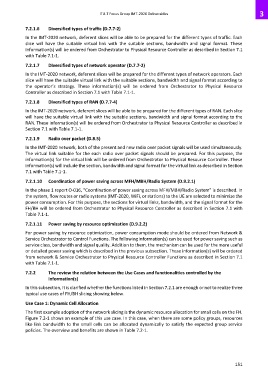Page 157 - ITU-T Focus Group IMT-2020 Deliverables
P. 157
ITU-T Focus Group IMT-2020 Deliverables 3
7.2.1.6 Diversified types of traffic (D.7.7-2)
In the IMT-2020 network, deferent slices will be able to be prepared for the different types of traffic. Each
slice will have the suitable virtual link with the suitable sections, bandwidth and signal format. These
information(s) will be ordered from Orchestrator to Physical Resource Controller as described in Section 7.1
with Table 7.1-1.
7.2.1.7 Diversified types of network operator (D.7.7-2)
In the IMT-2020 network, deferent slices will be prepared for the different types of network operators. Each
slice will have the suitable virtual link with the suitable sections, bandwidth and signal format according to
the operator’s strategy. These information(s) will be ordered from Orchestrator to Physical Resource
Controller as described in Section 7.1 with Table 7.1-1.
7.2.1.8 Diversified types of RAN (D.7.7-4)
In the IMT-2020 network, deferent slices will be able to be prepared for the different types of RAN. Each slice
will have the suitable virtual link with the suitable sections, bandwidth and signal format according to the
RAN. These information(s) will be ordered from Orchestrator to Physical Resource Controller as described in
Section 7.1 with Table 7.1-1.
7.2.1.9 Radio over packet (D.8.5)
In the IMT-2020 network, both of the present and new radio over packet signals will be used simultaneously.
The virtual link suitable for the each radio over packet signals should be prepared. For this purpose, the
information(s) for the virtual link will be ordered from Orchestrator to Physical Resource Controller. These
information(s) will include the section, bandwidth and signal format for the virtual link as described in Section
7.1 with Table 7.1-1.
7.2.1.10 Coordination of power saving across MFH/MBH/Radio System (D.9.2.1)
In the phase 1 report O-016, “Coordination of power saving across MFH/MBH/Radio System” is described. In
the system, flow routes or radio systems (IMT-2020, WiFi, or stations) to the UE are selected to minimize the
power consumption. For this purpose, the sections for virtual links, bandwidth, and the signal format for the
FH/BH will be ordered from Orchestrator to Physical Resource Controller as described in Section 7.1 with
Table 7.1-1.
7.2.1.11 Power saving by resource optimization (D.9.2.2)
For power saving by resource optimization, power consumption mode should be ordered from Network &
Service Orchestrator to Control Functions. The following information(s) can be used for power saving such as
service class, bandwidth and signal quality. Addition to them, the mechanism can be used for the more useful
or detailed power saving which is described in the previous subsection. These information(s) will be ordered
from network & Service Orchestrator to Physical Resource Controller Functions as described in Section 7.1
with Table 7.1-1.
7.2.2 The review the relation between the Use Cases and functionalities controlled by the
information(s)
In this subsection, it is clarified whether the functions listed in Section 7.2.1 are enough or not to realize three
typical use cases of FH/BH slicing showing below.
Use Case 1: Dynamic Cell Allocation
The first example adoption of the network slicing is the dynamic resource allocation for small cells on the FH.
Figure 7.2-1 shows an example of this use case. In this case, when there are some policy groups, resources
like link bandwidth to the small cells can be allocated dynamically to satisfy the expected group service
policies. The overview and benefits are shown in Table 7.2-1.
151

